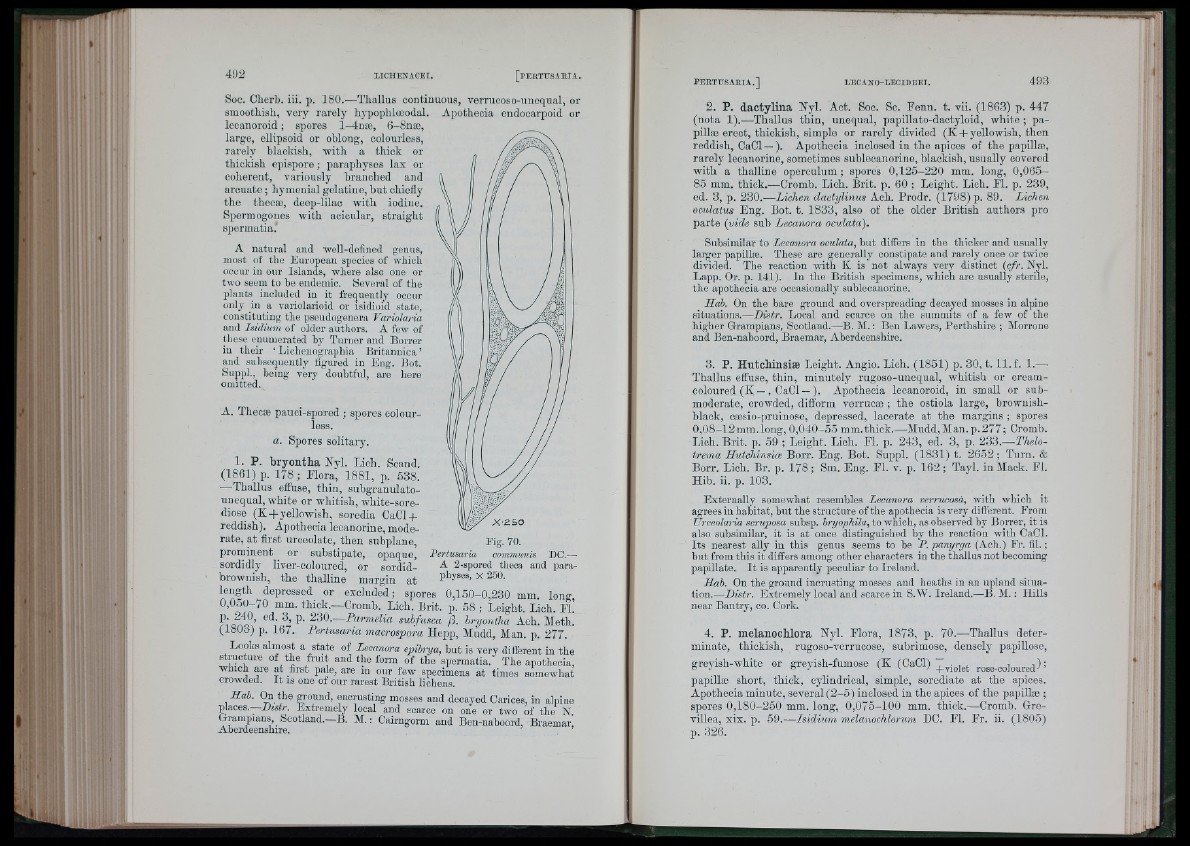
Soc. Clierb. iii. p. 180.—ïh a llu s continuous, verrucoso-unequal, or
smoothish, very rarely hypophloeodal. Apotheoia endooarpoid or
leoanoroid ; spores l-4 uoe , 6 -8næ,
large, ellipsoid or oblong, colourless,
rarely blackish, w ith a thiok or
thickish epispore ; paraphyses lax or
coherent, variously branched and
arcuate ; hymcuial gelatine, b u t chiefly
th e thecæ, deep-lilac w ith iodiue.
Spermogones with acioular, s tra ig h t
spermatia.
A natural and well-defined genus,
most of the European species of which
occur in our Islands, where also oue or
two seem to be endemic. Several of the
plants included in it frequently occur
only in a variolarioid or isidioid state,
constituting the pseudogenera Variolaria
and Isidiimi of older authors. A few of
these enumerated by Turner and Borrer
iu tbeir * Licheuographia Britannica ’
aud subsequently figured in Eng. Bot.
Suppl., being very doubtful, are here
omitted.
A. Thécoe pauci-spored ; spores colourless.
a. Spores solitary.
1. P. hryontha Nyl. Lich. Scand.
(1861) p. 178 ; Elora, 1881, p. 538.
— Thallus effuse, th in , subgranulato-
unequal, w hite or whitish, white-sore-
diose (K + yellowish, soredia CaCl +
reddish). Apotheoia leoanorine, modera
te , a t first urceolate, th eu subplane,
Pig. 70.
prominent or snbstipato, opaque,
sordidly liver-coloured, or sordid-
brownish, th e th allin e margin a t
length depressed or excluded; spores 0 ,1 5 0 -0 ,2 3 0 mm Ion»
0 ,0 5 0 -7 0 mm. thick.—Cromb. Lioh. Brit. p. 58 ; Leight. Lioh. EL
Pertusaria communis DO,—■
A 2-sporecl theca and paraphyses,
X 250.
230.—ParmihVi subfusca fr hryontha Ach. Meth.
(1803) p. 167. Pertusaria macrospora Hepp, Mudd, Man. p. 277.
Looks almost a state of Lecanora epibrya, hut is very different in the
structure of the fruit and the form of the spermatia. The apothecia,
which are J first pale, are in our few specimens at times smuewhat
crowded. I t is one of our rarest British lichens.
Hab. ( J the gi-ound, encrusting mosses and decayed Carices, in alpine
places. Distr. Extremely local and scarce on one or two of the N.
Grampians, _ Scotland.—B. AI. : Cairngorm and Ben-naboord, Braemar,
Aberdeenshire.
2. P. dactylina Nyl. Act. Soo. So. Fenn. t. vii. (1863) p. 447
(nota 1).—Thallus th in , unequal, papillato-daotyloid, white ; papillæ
erect, thiokish, simple or ra re ly divided (K-+-yellowish, then
reddish, CaCl — ). Apotheoia inclosed in th e apices of th e papillæ,
rarely lecanorine, sometimes sublecanorine, blackish, usually covered
with a thalline operculum ; sporos 0 ,1 2 5 -2 2 0 mm. long, 0 ,0 6 5 -
85 mm. thick.—Cromb. Lich. Brit. p. 60 ; Leight. Lioh. El. p. 239,
ed. 3, p. 230.—Lichen dactylinus Aoh. Prodr. (1798) p. 89. Lichen
oeulatus Eng. Bot. t. 1833, also of th e older British authors pro
p a rte (vide sub Lecanora oculata).
Suhsimilar to Lecanora oculata, but differs in the thicker and usually
larger papillæ. These are generally constipate and rarely once or twice
divided. The reaction with K is not always very distinct (cfr. Njd.
Lapp. Or. p. 141). lu the British specimens, which are usually sterile,
the apothecia are occasionally sublecanorine.
Hab. On the bare ground and overspreading decayed mosses in alpine
situations.—Histr. Local and scarce on the summits of a few of the
higher Grampians, Scotland.—B. AI. : Ben Lawers, Perthshire ; Alorrone
and Ben-naboord, Braemar, Aberdeenshire.
3. P. Hutchinsiæ Leight. Angio. Lioh. (1851) p. 30, t. 11. f. 1.—
ThaUus effuse, th in , minutely rugoso-unequal, whitish or cream-
coloured (K —, CaCl—). Apothecia lecanoroid, in small or submoderate,
crowded, difform verruoæ ; th e ostiola large, browuish-
black, cæsio-pruinose, depressed, lacerate a t th e margins ; spores
0 ,0 8 -1 2mm.long, 0 ,0 4 0 -5 5 mm.thick.—Mudd,Man. p .2 7 7 ; Cromb.
Lich. B rit. p. 59 ; Leight. Lioh. El. p. 243, ed. 3, p. 233.— Thelotrema
Hutchinsiæ Borr. Eng. Bot. Suppl. (1831) t. 2652 ; Turn. &
Borr. Lioh. Br. p. 1 7 8 ; Sm. Eng. F l. v. p. 1 6 2 ; Tayl. in Alack. Fl.
Hib. ii. p. 103.
Externally somewhat resembles Lecanora verrucosa, with which it
agrees in habitat, but tbe structure of the apothecia is very different. From
Urceolaria sm-uposa subsp. bryophila, to which, as observed by Borrer, it is
also subsimilar, it is at once distinguished bj' the reaction with CaCl.
Its nearest ally in this genus seems to be P. panyrga (Ach.) Fr. fil. ;
but from this it differs among other characters in the thallus not becoming
papillate. I t is apparently peculiar to Ireland.
Hab. On the ground incrusting mosses and heaths in an upland situation.—
Distr. Extremely local and scarce in S.W. Ireland.—B. AI. : Hills
near Bantry, co. Cork.
4. P. melanochlora Nyl. Flora, 1873, p. 70.—Thallus determinate,
thickish, rugoso-verrucose, subrimose, densely papillose,
greyish-white or greyish-fumose (K (CaCl) rose-coloured) ^
papillæ short, thick, cylindrioal, simple, sorediate a t the apices.
Apothecia minute, several (2 -5 ) inclosed in the apices of the papillæ ;
spores 0 ,1 8 0 -2 5 0 mm. long, 0 ,0 7 5 -1 0 0 mm. thiok.—Cromb. Grevillea,
xix. p. 59.—Isid ium melanochlorum DC. Fl. F r. ii. (1805)
p. 326.